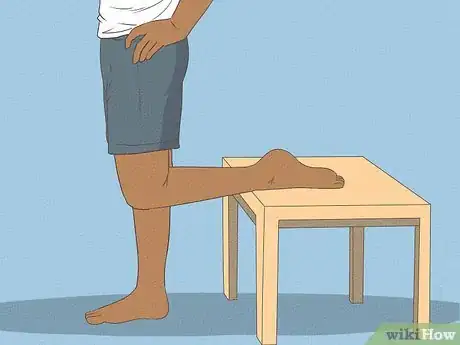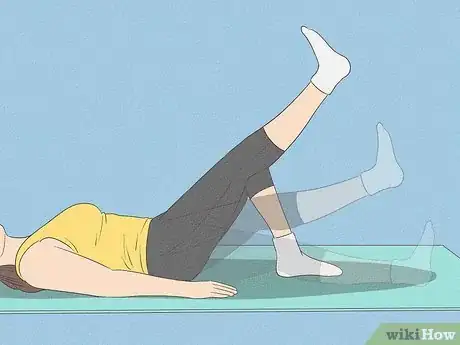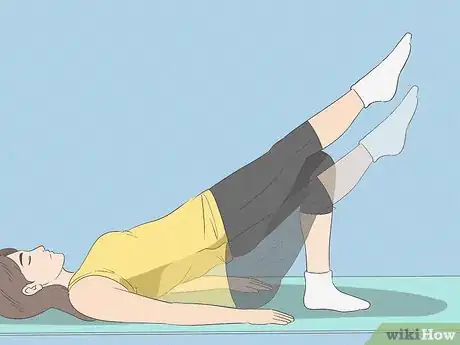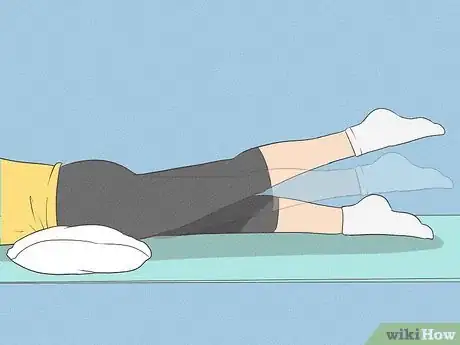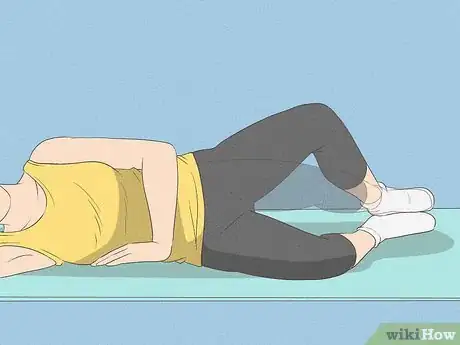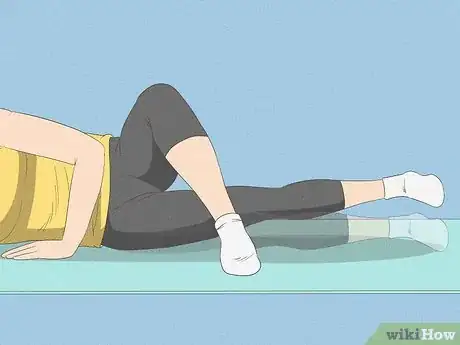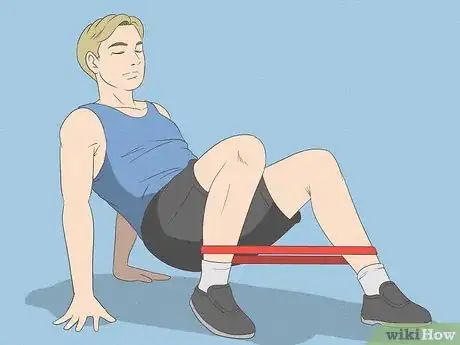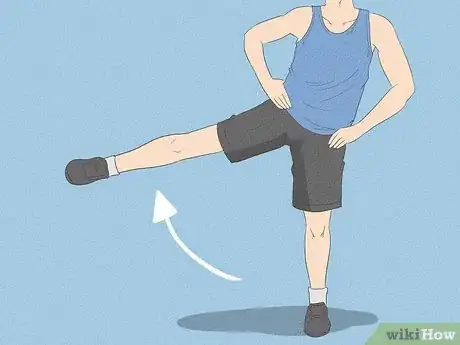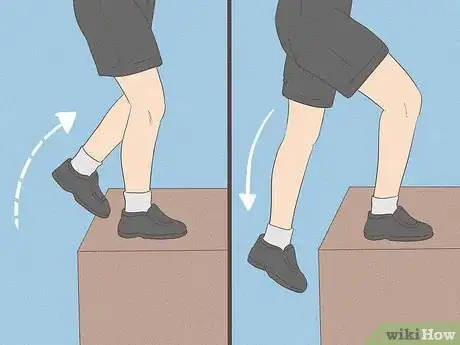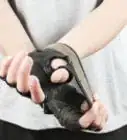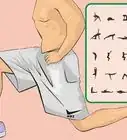This article was co-authored by Adam Shuty. Adam Shuty is a Certified Strength and Conditioning Specialist and owner of ATOMIC Total Fitness, a fitness training studio in New York, New York. With over 15 years of experience, Adam specializes in weightlifting, strength and conditioning, and martial arts. Adam holds a BS in Industrial Engineering from Virginia Polytechnic Institute and State University. In 2014, Adam appeared on the Live With Kelly and Michael Show as one of the top five fitness instructors in the country.
There are 16 references cited in this article, which can be found at the bottom of the page.
This article has been viewed 29,647 times.
Your hip joints do a lot of heavy lifting–from supporting your balance to letting you walk and move through your daily life. Strengthening your glutes and hip flexors (the muscles that support your hip) and improving your flexibility lets you reduce pain and prevent injury. Whether you’re looking to get a little more mobile, prevent injury and pain while walking or running, or whether you’re a senior seeking osteoarthritis relief, these at-home exercises will boost your hip joint strength and mobility. Aim to perform all these exercises 2-3 times per week, and aim to perform the stretches daily.
Steps
Front hip stretch
-
Loosen up your hips with this easy stretch. Stand on one leg and put your other leg on a step, bench, or sturdy chair. Lean forward gently towards the bent leg. Stop when you feel a stretch in the front of your hip. Hold that position for 30 seconds. Switch legs after you’ve done 3 holds on one side.[1] X Research source
- Do 3 reps of 30 second holds on each side.
- Try this stretch daily to increase your mobility.
Quadriceps stretch
-
Stretching your quads can help alleviate hip pain. Stand in front of a bench or sturdy chair. Shift your weight onto your right leg. Bend your left knee and put the instep of your left foot onto the bench or sturdy chair behind you. You should feel a stretch through the front of your left thigh and hip. Hold the stretch for 30 seconds, and switch legs after you’ve done 3 holds on one leg.[2] X Research source
- Do 3 reps of 30 second holds on each side.
- If you don’t feel a stretch through the front of your thigh and hip, try raising or lowering the surface behind you.
- Do this stretch in front of a counter if you need help balancing.
- Incorporate this stretch into your daily routine for added flexibility.
Knee hugs
-
Stretch and strengthen your hip flexors in this simple standing pose. Start with both feet on the ground together. Lift your knee to your chest. Grab below your knee with your hands and pull the knee into your chest. Squeeze your opposite glute for stability. Return to the starting position, and repeat on the other side.[3] X Research source
- Do 2 sets of 20 reps per side.
- For example, if you squeeze your right knee into your chest, you’ll squeeze your left glute to stabilize your lower body.
- For an advanced variation, add a calf raise. Extend onto your toes while you’re holding your knee to your chest.
- You can do this stretch daily.
Hip circles
-
Warm up your hips and start working on strength with this dynamic move. Stand on one leg, and bring your other leg up to a 90° angle. Flex your foot, and keep your pelvis level. Let your hip muscles guide your bent leg to move in a circle. You’ll start your leg in front of your body and move it to the side, to the back, and around to the front again. Switch legs once you’ve completed the total reps for one leg.[4] X Research source
- Do 1 set of 8 reps of outward-moving circles, then 8 reps of circles in the opposite direction.[5] X Research source
Supine leg raises
-
A supine leg raise is one of the simplest exercises for building hip strength. Lie on your back with one leg out straight and the other leg bent, with that foot flat on the ground. To perform the exercise, flex the foot on your straight leg. Slowly, lift your straight leg off the ground and then bring it back down. Switch legs once you’ve completed the total number of reps for one leg.[6] X Research source
- Do 3 sets of 10 reps on each side.[7] X Research source
Double leg bridges
-
This bridge exercise strengthens your glutes and hip flexors. Lie on your back with your heels close to your glutes. Tighten your abdominal muscles and raise your hips up towards the ceiling. Try to keep your back in a straight line. Flex your glutes at the top of the bridge, then lower back down slowly.[8] X Research source
- Do 1 set of 8-10 reps.
Single leg bridges
-
Take the double leg bridge to the next level with this exercise. Lie on your back with your heels close to your glutes. Then, lift one leg off the ground so that it’s perpendicular to the floor. If you can’t lift your leg totally perpendicular, just go as high as you can. Flex the foot of your lifted leg and try to keep that leg straight. Keep your leg lifted as you lift your hips off the ground and flex your glutes. Then, lower back down.[9] X Research source
- Do 1 set of 8-10 reps on each side.
Prone hip extensions
-
Prone hip extensions work your glutes and hip flexors. Start by lying on your stomach. Pick a firm, flat surface, and put a pillow under your hips. Bend one knee to 90°. Lift your leg and imagine trying to touch the ceiling with your heel. Lift as high as you can! Then, as you count to 5, lower your leg back down to the table.[10] X Research source
- Do 1 set of 8 reps on each side.
Clamshells
-
The clamshell is the best exercise to activate your anterior hip flexors.[11] X Trustworthy Source PubMed Central Journal archive from the U.S. National Institutes of Health Go to source Lie on your side, with a slight bend at your hips. Then, bend your knees to 90°. Keep your feet together, and lift your top knee so that you resemble an open clamshell.[12] X Research source
- Do 1 set of 8-10 reps on each side.
- Keep your hips “stacked” on top of each other. In other words, don’t let one hip shift forward or backward out of place.
Hip abduction
-
Your hip abductors are the outer crucial “stabilizing” muscles for your hips.[13] X Trustworthy Source Mayo Clinic Educational website from one of the world's leading hospitals Go to source To get into the starting position, lie on your side. Start with your weaker leg or hip on top. Bend your lower leg for easier balance and support. Straighten your top leg, then lift it up to a 45° angle above your body. Hold it at the top for 5 seconds. Then, slowly lower your leg back down to complete the rep.[14] X Research source
- Do 1 set of 8 reps on each side.
- You’ll feel this exercise in your outer hip and glutes.
Hip adduction
-
Adductors are the inner “balancing” muscles for your hips and lower body.[15] X Research source Lie on your side with both legs straight. Put your hand on the floor by your belly for extra stability. If you have an injured leg or weak side, start with that leg on the bottom. Bend your top leg and cross it over the bottom leg. Then, raise the lower leg off the floor about 6–8 inches (15–20 cm). Hold at the top of the lift for 5 seconds. Slowly lower your leg back down to complete the rep.[16] X Research source
- Do 1 set of 8 reps on each side.
- You’ll feel this exercise in your inner thigh.
Crab walk
-
This stabilizing exercise is great for walkers and runners. Use a resistance band to tie a tight loop around your ankles. Then, take a series of small baby steps to the left and right. You should feel tension in your outer hips.[17] X Trustworthy Source Mayo Clinic Educational website from one of the world's leading hospitals Go to source
- Do 3 sets of 10 steps to the left and 10 steps to the right.[18] X Research source
- Don’t lock your knees. Keep them gently bent.
Lateral leg raises
-
You can easily do this exercise easily without equipment or add a resistance band. We’ll walk you through the no-equipment version first. Stand with your feet together. Then, slowly raise one of your legs off the ground and out to the side, as high as you can without moving your upper body. Slowly lower back down to complete 1 rep.[19] X Trustworthy Source Mayo Clinic Educational website from one of the world's leading hospitals Go to source
- Do 1 set of 12-15 reps.
- To add resistance, loop a band around the leg you’re raising. The band should be anchored on table leg or chair leg so that it resists your outward motion.
Single leg mini squats
-
Single leg mini squats improve your balance and stability through your hips. Stand with your hand against a wall if you need extra support. Shift your weight onto one leg, and hold the other leg slightly bent behind you. Bend the knee of your standing leg to perform a “mini squat.” Envision yourself sitting down in a chair to make sure your weight stays in your heel. Straighten the leg to complete the rep.[20] X Research source
- Do 3 sets of 20 reps on each leg.
- As you get more comfortable with this, you can move into more challenging squats, like the squat sit, Cossack squat, and spider lunge.[21]
X
Expert Source

Certified Strength & Conditioning Specialist Expert Interview. 4 September 2020.
Elbow toe touch
-
Improve your hip flexibility by trying to touch your toes with your elbows. Bend down like you're going for a normal toe touch, but when you get to the bottom, fold your arms in front of you like a genie. Keep bending down like you're trying to touch your elbows to your toes, but each time you repeat the move, slide your feet a little further apart. Eventually, you'll be in about a 3/4 split, and you'll be able to touch the ground with your arms.[22] X Expert Source

Certified Strength & Conditioning Specialist Expert Interview. 4 September 2020.
Step ups
-
Use step ups to improve your knee and hip strength simultaneously. Put your right foot onto a step in front of you. Raise your left foot up slowly until it’s at the level of your right foot, but don’t let it rest on the step. Press down through your right heel and tighten your glutes to activate your lower body muscles. Lower your left foot back down slowly over a count of 4. Complete the total reps for one leg, then switch.[23] X Trustworthy Source Centers for Disease Control and Prevention Main public health institute for the US, run by the Dept. of Health and Human Services Go to source
- Do 1 set of 10 reps for each leg.
- Hold onto a railing if you need extra support.
- You can even add weight to this exercise by holding a dumbbell or kettlebell in each hand, and letting your hands hang by your sides.
You Might Also Like
 What Does Sleeper Build Mean on Social Media?
What Does Sleeper Build Mean on Social Media?

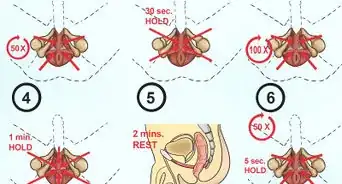
 How to Build Bigger Biceps at Home (According to the Experts)
How to Build Bigger Biceps at Home (According to the Experts)
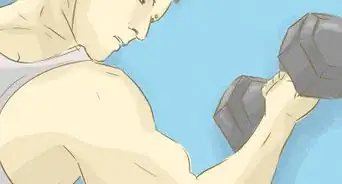
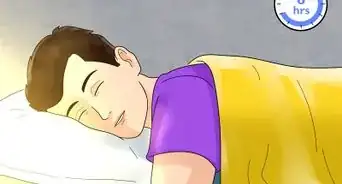
-Step-24.webp)
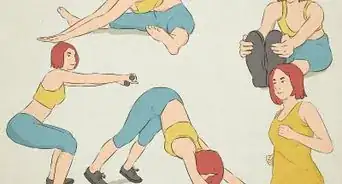 How to Gain Muscle When You're Skinny
How to Gain Muscle When You're Skinny

References
- ↑ https://uihc.org/sites/default/files/exercises_for_chronic_hip_pain.pdf
- ↑ https://uihc.org/sites/default/files/exercises_for_chronic_hip_pain.pdf
- ↑ https://www.researchgate.net/publication/316052156_Return_to_running_after_arthroscopic_hip_surgery_literature_review_and_proposal_of_a_physical_therapy_protocol
- ↑ https://www.youtube.com/watch?v=yFi1FDOFXq0&t=7s
- ↑ https://www.gymguider.com/the-best-5-minute-warm-up-to-do-before-a-strength-workout/
- ↑ https://www.youtube.com/watch?v=s7WBpar9W6w&t=159s
- ↑ https://www.basd.net/cms/lib/PA01001269/Centricity/Domain/1342/Upper%20Leg%20Strength.pdf
- ↑ https://uhs.princeton.edu/sites/uhs/files/documents/Pelvic-Stabilization-Hip-Strengthening.pdf
- ↑ https://uhs.princeton.edu/sites/uhs/files/documents/Pelvic-Stabilization-Hip-Strengthening.pdf
- ↑ https://orthoinfo.aaos.org/en/recovery/hip-conditioning-program/
- ↑ https://www.ncbi.nlm.nih.gov/pmc/articles/PMC3418110/
- ↑ https://uhs.princeton.edu/sites/uhs/files/documents/Pelvic-Stabilization-Hip-Strengthening.pdf
- ↑ https://www.mayoclinic.org/healthy-lifestyle/fitness/multimedia/hip-abduction-walk/vid-20084671
- ↑ https://orthoinfo.aaos.org/en/recovery/hip-conditioning-program/
- ↑ https://www.kenhub.com/en/library/anatomy/the-hip-adductors
- ↑ https://orthoinfo.aaos.org/en/recovery/hip-conditioning-program/
- ↑ https://www.mayoclinic.org/healthy-lifestyle/fitness/multimedia/hip-abduction-walk/vid-20084671
- ↑ https://sportsrehab.ucsf.edu/sites/sportsrehab.ucsf.edu/files/Hip%20Strengthening%20Protocol.pdf
- ↑ https://www.mayoclinic.org/healthy-lifestyle/fitness/multimedia/standing-hip-abduction/vid-20084670
- ↑ https://www.physio-pedia.com/Therapy_Exercises_for_the_Hip
- ↑ Adam Shuty. Certified Strength & Conditioning Specialist. Expert Interview. 4 September 2020.
- ↑ Adam Shuty. Certified Strength & Conditioning Specialist. Expert Interview. 4 September 2020.
- ↑ https://www.cdc.gov/physicalactivity/downloads/growing_stronger.pdf
- ↑ Adam Shuty. Certified Strength & Conditioning Specialist. Expert Interview. 4 September 2020.
About This Article


